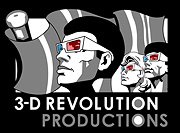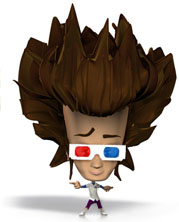3D Stereoscopic film and television for children's eyes: safety first
At this year’s MIPtv ‘3DTV State of the market’ conference presentation, the International 3D Society of America’s Jim Chabin did a keynote speech about the state of 3DTV. As is really very usual with these talks, the focus of the talk was all context of 3DTV, not at all the content. 3-D industry boffins love talking about numbers of 3DTVs sold and projected 3DTV sales, but very rarely do talks actually go into the content side of the subject, being the technical and creative requirements of 3-D production - let alone GOOD 3-D production. This is something I myself do whenever I get given the chance at talks, panels and workshops and I always get very positive feedback on the fact that I am one of the rare few people talking details and not just course outlines. Either way, Jim managed to make a bold statement I have to comment on because it goes to the core of a subject very close to my heart and professional knowledge.
I won’t go into the much repeated number of 40+ 3DTV channels as mentioned again by Jim, omitting the fact that 30 of these channels are adult entertainment channels – which is fine, but inconvenient for a medium presenting itself as the ultimate family viewing experience. And I won’t go into the part about Youtube and NVidia offering 3-D channels since they are not paying for the 3-D content on their channels, which makes mentioning them as a platform somewhat of a moot point (there are well paying 3-D channels in boradcast and IPTV out there, mind you). What I would like to discuss is Jim’s statement that research from the American Optometric Association says that 3-D is not harmful to young eyes - period.
It is true that the AOA has published a Q&A on 3-D and child viewer issues, but they have done so in collaboration with the 3D@Home Consortium, and the statement reads as follows:
(Question) At what age can my child view 3D safely?
(Answer) Vision, including binocular vision, develops from birth. No detrimental effects of viewing 3D have been reported at any age. Parents should note that from 6-12 months of age, basic binocularity is established. By the age of 3 years most children will have binocular vision well enough established to enjoy viewing 3D television, movies or games.
With this answer, 3D@Home and the AOA are certainly not lying, but they are omitting a vital piece of information. They are telling only half the story - and quoting this statement does not do the job of addressing the issue of 3-D kids content safety.
The point is that it matters just as much whether children CAN see 3-D content at all as what the quality of this content actually is. Not a popular subject in America, I know, but a very popular subject in Europe, especially when it comes to public TV broadcasters and children's content distributors. 3-D content in itself is not the problem; it is the parameters of the content that poses a risk to children's enjoyment and eye health. Just as a flashing light is not a problem in itself, repeated flashes and patterns can cause an epileptic fit with epilepsy sufferers and are thus outlawed in film and television to prevent seizures with the audience (the Harding Flash and Pattern Analyser is used to check all broadcast television for this). The same goes for 3-D content and how the 3-D camera, composition and editing have been employed, yet the quality and suitability of 3-D has not yet been regulated by EBU, SMPTE, FCC or likewise. Your fallback position is a stereoscopic expert to give you real guarantees based on the latest research and industry experience.
An organization like the AOA should be taking a positive lead in the matter, but they choose the route of omission of information to remove doubt, which is something I am sure their 36,000 optometrist members don't agree with if they knew about it. What I am talking about here is producers potentially trying to take responsibility for the products offered to their child audience, but being guided by incomplete statements from leading optometry and stereoscopy organizations.
The core problem is that 3-D offers a completely unnatural viewing situation, regardless of production methods employed. While the actual 3-D imagery is projected or presented on the cinema or TV screen, the brain thinks the imagery is located in the space in front or behind the screen. This can force the eyes to work extremely hard, per the choice of parallax, volume, depth budget, depth placement, layout, points of interest, camera movement, focus and editing. As such, for many people, especially children, 3-D can cause eye strain, headaches and dizziness. Children’s eyesight, then, is developing rapidly in the early years, usually reaching its full potential by the age of around five or six, although new research shows that the children’s eyesight can remain flexible into their teens.
Besides needing a calm, educated 3-D layout, children need a clear, sharp image in each eye in order for their vision to develop properly. If anything upsets that balance (natural or artificial) it could affect the visual development resulting in 'amblyopia' (lazy eye) or a squint. 3-D film imagery for children needs to be tailored to the peculiarities of children's eyes - and this is completely possible by adjusting 3-D production methods and protocols. 3-D Revolution Productions is a specialist in the field and can help your production produce these safe, enjoyable 3-D results –for children and of course also for adults.
A recent and rather poignant example of 3-D film imagery that is not just painful to watch but cruel eye torture for children under the age of 8, can be found in the family film 'Hugo Cabret (Hugo 3D)'. Tell me, 3D@Home & AOA, that this imagery is watchable by 3-8 year olds without causing them discomfort, eyestrain and potentially damage to the eye muscles and nerves.
These shots already use 2 to 3 times more parallax than is comfortable and enjoyable to adult eyes, so for 3-5 year olds the parallax values exceed comfortable levels by 4.5 to 6.5 times. These shots really do create decoupling and divergence and I would personally request a rework (post fixing) of these shots to present them to children happily and safely, had I been asked to do 3-D QC on this production.
It is either a massive oversight or who knows, there may be a conflict of interest at play here. If that is so, there will probably never be an admission to the existence of problems by the big players of the 3-D film industry. What is 3D@Home promoting and who are their subsidiaries? 3-D content viewing at home and its 3DTV screens. What is the AOA selling? 36,000 American optometrists and their check-up services. And what am I selling here then? 3-D Quality Consultation and Certification from the perspective of end user enjoyment.
3D ROI comes from positive viewer enjoyment and word of mouth, not from talking straight a crooked product at TV conferences. At the end of the day it really is not necessary to present your audience with problematic 3-D imagery - just a matter of proper planning and keeping your true audience in mind at all times.
As a 3-D children's content producer, now or in the future, the issue of 3-D enjoyment for children is yours to work with. It is a massive issue and one that doesn't just go away with time and technological advancement because it is an optical issue. There are production methods that can ensure child enjoyment and child safety, applicable during production or in post-production. Allow me to consult you on those methods and guide you to a successful and safe 3-D end result. You can either take a massive gamble or take serious responsibility for your product and its consumer enjoyment. And I will happily sign that statement.
Signed,
Alexander Lentjes
Stereoscopic Consultant
Specialized in Children's Media
www.the3drevolution.com
Signed,
Alexander Lentjes
Stereoscopic Consultant
Specialized in Children's Media
www.the3drevolution.com















